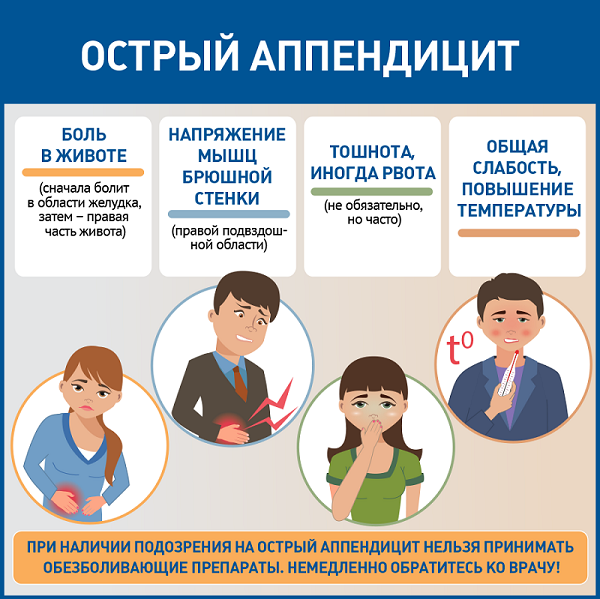Acute appendicitis
What is an "appendix" and why does it become inflamed?

The appendix extends from the lower end of the cecum (the initial part of the colon intestines). It is believed that the appendix is one of the links of the immune system, since the mucous membrane of the appendix is rich in lymphoid tissue. It is generally believed that inflammation of the appendix can occur due to blockage of the lumen of the appendix by enlarged lymphoid tissue, fecal stones (hard feces, the result of chronic constipation), a foreign body and sometimes worms. The blockage leads to an expansion of the appendix cavity, rapid development of infection and inflammation. However, the exact cause of this common disease is not clear.
Symptoms of acute appendicitis
The manifestations of acute appendicitis depend on the location of the appendix, the time elapsed from the onset of the disease, the severity of the inflammatory process in the appendix and the involvement of nearby organs and the peritoneum, as well as on the age of the patient and the presence of he has concomitant diseases.
Since the appendix is a mobile organ, its inflammation can mimic almost any disease. In some cases, doctors have difficulty making a diagnosis, since the main symptom of appendicitis is pain, which can occur not only in the lower right abdomen, where it should be located according to the anatomy of the cecum, but also in the navel, groin, pubis, lower back, and right hypochondrium. diseases of the liver, kidneys, and female genital organs.
As a rule, the disease begins with the appearance of pain in the upper abdomen, which gradually increases and moves to the right iliac region (the right lower quadrant of the abdomen). The pain increases with coughing and movement. A subfebrile body temperature of 37.2-37.5 °C is usually observed. An examination of the abdomen reveals involuntary tension of the muscles of the anterior abdominal wall and soreness in the right iliac region. The pain is constant, and may be accompanied by nausea, and sometimes vomiting. Loss of appetite and refusal of food are often observed, as well as stool retention caused by limited intestinal motor function due to inflammation spreading through the peritoneum.

Unfortunately, these classic signs of appendicitis are observed in just over half of patients with acute appendicitis. The pain may not have a clear localization, especially in children under 3 years of age. In elderly and senile patients, decreased reactivity of the body, connective tissue replacement of all layers of the wall of the appendix and its blood vessels contribute to poor symptoms of acute appendicitis and a large number of complicated forms. In pregnant women in the second and third trimesters, an appendix displaced by the uterus may cause an atypical clinical picture. Therefore, patients with acute appendicitis are often admitted to the emergency surgery department with complications (process perforation, peritonitis).
What are "phlegmonous" and "gangrenous" appendicitis?
If the patient's symptoms of appendicitis are not pronounced clearly, but, nevertheless, the inflammatory process develops (the pain is not very severe, there is no nausea and vomiting), he does not rush to seek medical help, and then catarrhal appendicitis turns into a phlegmonous form. The appendix fills with pus, ulcerates. The inflammation begins to spread to the surrounding tissues: intestinal walls, peritoneum. The pain becomes more pronounced and increases with tension in the abdominal muscles; in thin people, the inflamed appendage can be felt like a dense roller.
Phlegmonous appendicitis can develop into gangrenous form when the inflammatory process develops already in the abdominal cavity.With gangrenous appendicitis, there is a decrease or complete absence of pain associated with the death of the nerve endings of the appendix, but it is replaced by signs of general intoxication, deterioration of the general condition: weakness, pallor, bloating. If the patient is not treated at this stage, the patient's life is at risk due to the development of peritonitis.
How is appendicitis diagnosed?
If acute appendicitis is suspected, the patient must be urgently hospitalized in a surgical hospital. Emergency operations for acute appendicitis and its complications are performed around the clock at the EMC Surgical Clinic.
At the stage before hospitalization, even in the presence of severe pain, painkillers should not be taken, as this may make it difficult to diagnose the disease. Antibiotics should also not be used, as this may blur the picture with the further development of complications (process perforation, diffuse peritonitis).
Diagnosis begins with a thorough examination and examination, as well as taking a blood test (a general blood test usually reflects the picture of inflammation —the number of white blood cells increases, leukocytosis occurs). In the classic course of acute appendicitis (high fever and soreness in the right iliac region from tolerable to very severe), diagnosis is not difficult. For patients with questionable or indistinct symptoms, doctors may prescribe ultrasound of the abdominal cavity and small pelvis and/or computed tomography upon admission to the hospital.
In some cases, diagnostic laparoscopy can be performed, a diagnostic procedure in which a thin fiber–optic tube with a camera is inserted into the abdominal cavity through a small hole in the abdominal wall. Laparoscopy allows you to see the appendix and other organs of the abdominal cavity and pelvis and assess their condition.
Emergency care for acute appendicitis
An operation to remove appendicitis (an inflamed appendix) is called an "appendectomy," in which the inflamed appendix is removed.
In the presence of a perforation (rupture) of the appendix, surgical intervention becomes more difficult to perform. There is a need for thorough "washing" of the abdominal cavity from pus. Consequently, the operation itself and recovery may be delayed.
The removal of the appendix is preceded by intravenous antibiotics to prevent complications. In the presence of appendix perforation, antibiotic treatment continues until blood tests return to normal (approximately 5-7 days). The question of the abolition of antibiotics is decided by the attending physician.
Laparoscopic appendectomy
As a rule, in EMC, most surgical interventions for acute appendicitis, even in the case of severe forms of the disease, are performed by laparoscopic access, which guarantees a minimum of pain and a shorter recovery period. In uncomplicated appendicitis, if the appendix has not been perforated, the patient is usually discharged the next day. Patients with a perforated appendix may stay in the clinic longer (up to 7 days), especially if peritonitis develops.
However, there are a number of cases where surgery using the traditional open method (open appendectomy) is preferable.
With timely surgical intervention, recovery occurs quickly.
Why the EMC
The first and only clinic in Russia, created in the image of the world's leading clinics
EMC is a multidisciplinary center offering patients a high level of medical services and a personalized approach
Worldwide recognition and awards
 Learn more
Learn more
Worldwide recognition and awards
 Certificates and licenses
Certificates and licenses
Make an appointment for a consultation
Specify your contacts and we will contact you to clarify the details
Reviews
and new products of the EMC
.webp)







.webp)

.webp)
.webp)





.webp)


